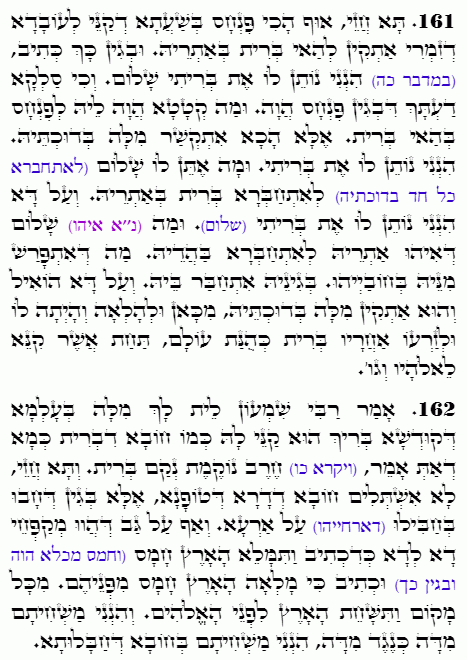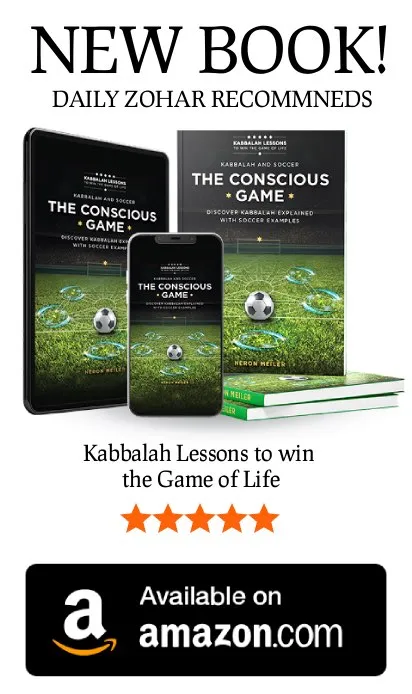Daily Zohar # 4691 – Noach – The cause of the flood
Daily Zohar 4691

Hebrew translation:
162. אָמַר רַבִּי שִׁמְעוֹן, אֵין לְךָ דָּבָר בָּעוֹלָם שֶׁהַקָּדוֹשׁ בָּרוּךְ הוּא מְקַנֵּא לוֹ כְּמוֹ חֵטְא הַבְּרִית, כְּמוֹ שֶׁנֶּאֱמַר (ויקרא כו) חֶרֶב נֹקֶמֶת נְקַם בְּרִית. וּבֹא וּרְאֵה, לֹא הֻשְׁלַם חֵטְא דּוֹר הַמַּבּוּל אֶלָּא מִשּׁוּם שֶׁחָטְאוּ בְּהַשְׁחָתַת דַּרְכָּם עַל הָאָרֶץ, וְאַף עַל גַּב שֶׁהָיוּ חוֹמְסִים זֶה אֶת זֶה, כַּכָּתוּב וַתִּמָּלֵא הָאָרֶץ חָמָס [וְחָמָס מֵהַכֹּל הָיָה, וְלָכֵן], וְכָתוּב כִּי מָלְאָה הָאָרֶץ חָמָס מִפְּנֵיהֶם. מִכָּל מָקוֹם וַתִּשָּׁחֵת הָאָרֶץ לִפְנֵי הָאֱלֹהִים. וְהִנְנִי מַשְׁחִיתָם – מִדָּה כְּנֶגֶד מִדָּה. הִנְנִי מַשְׁחִיתָם בְּחֵטְא הַהַשְׁחָתָה.
.
Zohar Noach
Continued from previous DZ
#161
Come and see, the same applies to Pinchas. When he acted zealously against the actions of Zimri, he repaired this covenant in its place. This is why it is written, “הִנְנִי נֹתֵן לוֹ אֶת בְּרִיתִי שָׁלוֹם” “Behold, I give him My covenant of peace” (Numbers 25:12). Would it be possible to think that peace was solely for Pinchas? And what conflict did Pinchas have with this covenant? Rather, here in the word “peace” (שָׁלוֹם), the matter was restored to its place. The meaning is “I give him My covenant,” what do I give him? Peace, which here implies union (זיווג)—that the house (Malchut) may connect in its rightful place.
Thus, it says, “Behold, I give him My covenant of peace.” What is peace? It is the place where connection occurs, meaning the unification with Malchut, which is called peace. That which had separated from the Yessod due to Israel’s sins—namely, the Malchut that had separated from Yessod—was restored and reconnected through Pinchas. Therefore, since he restored this matter to its rightful place from then onward, “וְהָיְתָה לוֹ וּלְזַרְעוֹ אַחֲרָיו בְּרִית כְּהֻנַּת עוֹלָם תַּחַת אֲשֶׁר קִנֵּא לֵאלֹהָיו” “it was for him, etc.”
#162
Rabbi Shimon said: There is nothing in the world for which the Holy One, Blessed be He, is more zealous than the sin of violating the covenant (חֵטְא הַבְּרִית). As it says, “חֶרֶב נֹקֶמֶת נְקַם בְּרִית” “A sword that takes vengeance for the covenant” (Leviticus 26:25). Come and see, the sin of the generation of the Flood was not complete except due to their corrupting their ways upon the earth. Although they committed evil against each other, as it is written, “The earth was filled with violence” (Genesis 6:11). It says, “כִּי מָלְאָה הָאָרֶץ חָמָס מִפְּנֵיהֶם” “for the earth is filled with violence” (Genesis 6:13), nonetheless, it is written, “וַתִּשָּׁחֵת הָאָרֶץ” “the earth was corrupted”(Genesis 6:12), and “וְהִנְנִי מַשְׁחִיתָם” “I am about to destroy them” (Genesis 6:13). This implies a measure-for-measure punishment: “I am about to destroy them” because of their sin of corrupting seed. Thus, their sentence was sealed only because of the desecration of the covenant.
Notes:
The Zohar teaches that violating the covenant is among the gravest of offenses, and this transgression ultimately sealed the fate of the generation of the Flood. Although they committed numerous sins, the true desecration lay in corrupting the covenant—through moral degradation and misuse of reproductive power, which is essential to the continuation of life. This was the definitive factor that led to their destruction.
The passage emphasizes the critical role of upholding the covenant as a foundational element of Hashem’s order and purity. The principle of measure-for-measure justice underscores that actions against the covenant, which is intrinsically tied to life, result in consequences symbolized by death. Such breaches not only affect physical existence but also bring about the breakdown of sustenance, relationships, and the flow of blessings, representing a spiritual death in many areas of life.
Because the covenant is rooted in Yessod—the channel through which the Light of sustenance flows—sins related to this aspect, disrupt the flow, leading to impediments or terminations in areas of sustenance, relationships, and other essential aspects of life. The Zohar thus highlights the unique and pervasive impact of moral integrity and adherence to the covenant, stressing that this observance sustains both spiritual and material life.
{||}

 Previous: Noach
Previous: Noach

